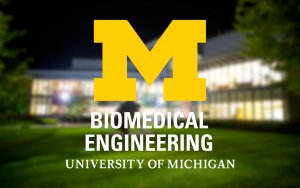Presented By: Biomedical Engineering
Restoring Fine Motor Prosthetic Hand Control Via Peripheral Neural Technology
Final Oral Examination - Philip Vu

Losing a limb can drastically alter a person’s way of life, and in some cases, brings great financial and emotional burdens. In particular, upper-limb amputations means losing the ability to do many daily activities that are normally simple with intact hands. Prosthesis technology has significantly advanced in the past decade to replicate the mechanical complexity of the human hand. However, current commercial user-to-prosthesis interfaces fail to provide users with full intuitive control over the many functionalities advanced prosthetic hands can offer. Research in developing new interfaces for better motor control has been on the rise, focusing on tapping directly into the peripheral nervous system. The aim of this work is to characterize and validate the properties of a novel peripheral interface called the Regenerative Peripheral Nerve Interface (RPNI) to improve fine motor skills for prosthetic hand control.
The first study characterizes the use of RPNI signals for continuous hand control in non-human primates. In two rhesus macaques, we were able to reconstruct continuous finger movement offline with an average correlation of ρ = 0.87 and root mean squared error (RMSE) of 0.12 between actual and predicted position across both macaques. During real-time control, neural control performance was slightly slower but maintained an average target hit success rate of 96.70% compared to physical hand control. The results presented in this study demonstrate an important step in exploring the RPNI’s potential capabilities to provide patients with more naturalistic control of their prosthetic limbs.
The second study presents the viability of the RPNI in humans who have suffered from upper-limb amputations. In three participants with transradial amputations, ultrasound demonstrated strong contractions of P1 and P2’s median RPNIs during flexion of the phantom thumb, and ulnar RPNI contractions during small finger flexion. In P1, the median RPNI and ulnar RPNIs produced signals with a signal-to-noise ratio (SNR) of 4.62 and 3.80, respectively. In P2, the median RPNI and ulnar RPNI had an average SNR of 107 and 35.9, respectively, while P3’s median RPNI and ulnar RPNIs had an average SNR of 22.3 and 19.4, respectively. This study provides evidence that the transected peripheral nerves have reinnervated the RPNI muscle grafts allowing RPNIs to transduce and amplify efferent motor action potentials during volitional individual finger movements.
The final study characterizes the capabilities of RPNI signals to predict continuous finger position in human subjects. Two participants, P2 and P3, successfully hit targets during a center-out target task with 92.4 ± 2.3% accuracy, controlling RPNI-driven one DOF finger movements. Comparably, non-RPNI driven finger movement had similar accuracy and performance. Without recalibrating parameter coefficients, no decreasing trend in motor performance was seen for all one DOF finger control across 300 days for P2 and 40 days for P3, suggesting that RPNIs can generate robust control signals from day to day. Lastly, using RPNI-driven control, P2 and P3 successfully manipulated a two DOF virtual and physical thumb with 96.4 ± 2.5% accuracy. This study demonstrates that RPNIs are capable of robust continuous control of one DOF finger movements and also capable of providing two DOF thumb movements. RPNIs may be a viable option to advance peripheral nerve interfaces into clinical reality and enhance neuroprosthetic technology for people with limb loss.
Chair: Cynthia Chestek
The first study characterizes the use of RPNI signals for continuous hand control in non-human primates. In two rhesus macaques, we were able to reconstruct continuous finger movement offline with an average correlation of ρ = 0.87 and root mean squared error (RMSE) of 0.12 between actual and predicted position across both macaques. During real-time control, neural control performance was slightly slower but maintained an average target hit success rate of 96.70% compared to physical hand control. The results presented in this study demonstrate an important step in exploring the RPNI’s potential capabilities to provide patients with more naturalistic control of their prosthetic limbs.
The second study presents the viability of the RPNI in humans who have suffered from upper-limb amputations. In three participants with transradial amputations, ultrasound demonstrated strong contractions of P1 and P2’s median RPNIs during flexion of the phantom thumb, and ulnar RPNI contractions during small finger flexion. In P1, the median RPNI and ulnar RPNIs produced signals with a signal-to-noise ratio (SNR) of 4.62 and 3.80, respectively. In P2, the median RPNI and ulnar RPNI had an average SNR of 107 and 35.9, respectively, while P3’s median RPNI and ulnar RPNIs had an average SNR of 22.3 and 19.4, respectively. This study provides evidence that the transected peripheral nerves have reinnervated the RPNI muscle grafts allowing RPNIs to transduce and amplify efferent motor action potentials during volitional individual finger movements.
The final study characterizes the capabilities of RPNI signals to predict continuous finger position in human subjects. Two participants, P2 and P3, successfully hit targets during a center-out target task with 92.4 ± 2.3% accuracy, controlling RPNI-driven one DOF finger movements. Comparably, non-RPNI driven finger movement had similar accuracy and performance. Without recalibrating parameter coefficients, no decreasing trend in motor performance was seen for all one DOF finger control across 300 days for P2 and 40 days for P3, suggesting that RPNIs can generate robust control signals from day to day. Lastly, using RPNI-driven control, P2 and P3 successfully manipulated a two DOF virtual and physical thumb with 96.4 ± 2.5% accuracy. This study demonstrates that RPNIs are capable of robust continuous control of one DOF finger movements and also capable of providing two DOF thumb movements. RPNIs may be a viable option to advance peripheral nerve interfaces into clinical reality and enhance neuroprosthetic technology for people with limb loss.
Chair: Cynthia Chestek